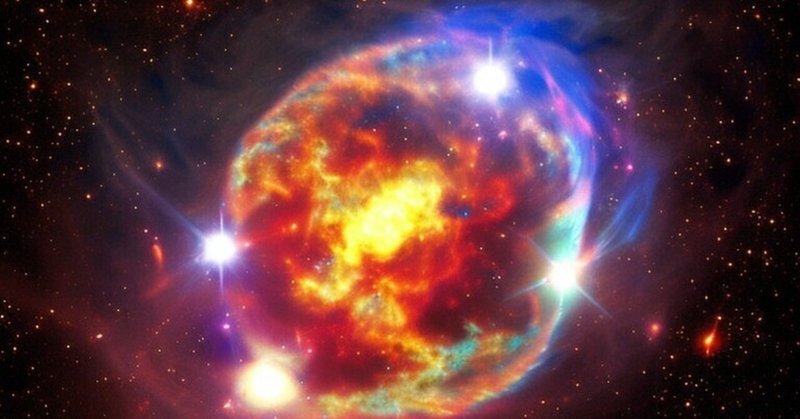
英語長文問題クエスト Part 85 (テーマ:超新星爆発)
英語の読解力を伸ばすには多読が必須!特に、TOEFL ibt というテストでは、かなり高度な読解力が必要ですし、何より、このTOEFL ibt という試験が難しいことの理由の1つに、日本語でも勉強していないアカデミックな内容の文章が出題されることです。
このクエストを進めれば、英語の読解力と知識を同時にアップデートさせられるでしょう!
さぁ、今日のクエストを進めてみましょう!
Passages
Title: Supernovae: Cosmic Cataclysms and Stellar Phenomena
Supernovae are among the most dramatic and energetic events in the universe. These catastrophic explosions mark the end of a star's life, and in their violent brilliance, they release more energy in a few weeks than our sun will emit over its entire lifetime. The study of supernovae has provided profound insights into the life cycles of stars, the formation of elements, and the expansion of the cosmos.
Formation of Supernovae
Supernovae can be broadly categorized into two main types: Type I and Type II. Type I supernovae typically occur in binary star systems when a white dwarf star accretes matter from a companion star, causing it to exceed a critical mass. The resulting explosion is incredibly uniform in brightness, making Type I supernovae valuable for measuring cosmic distances.
Type II supernovae, on the other hand, involve the collapse of massive stars. These stars, at least eight times the mass of our sun, exhaust their nuclear fuel and can no longer maintain the pressure needed to support their cores. When gravity takes over, the star's core rapidly contracts and then rebounds, triggering a massive shockwave that tears the star apart.
Emissions and Remnants
Supernovae emit vast amounts of energy and light, often outshining entire galaxies for a brief period. During the explosion, they release elements forged within the star's core through nucleosynthesis. These elements, including heavy metals like iron and gold, are scattered into space, eventually becoming part of the raw materials for new stars and planetary systems.
After the explosion, supernovae leave behind various remnants, depending on the mass of the core left after the explosion. If the core is massive enough, it may collapse further to form a neutron star or even a black hole. These remnants continue to be highly active, emitting X-rays and other forms of radiation.
Cosmic Significance
Supernovae play a crucial role in the evolution of galaxies and the composition of the universe. The energy and elements they release influence the formation of new stars, planetary systems, and, ultimately, the existence of life. For instance, all the elements essential for life, including carbon, oxygen, and nitrogen, are produced within the cores of massive stars and released into space through supernova explosions.
Moreover, supernovae have been instrumental in measuring cosmic distances and understanding the expansion of the universe. By observing the brightness and spectra of Type I supernovae, astronomers have made groundbreaking discoveries about the accelerated expansion of the cosmos, leading to the concept of dark energy, one of the most profound mysteries in contemporary astrophysics.
Questions
What distinguishes Type I supernovae from Type II supernovae?
A) Type I supernovae involve the collapse of massive stars.
B) Type I supernovae occur in binary star systems.
C) Type I supernovae emit heavy metals.
D) Type I supernovae leave behind neutron stars.What triggers a Type II supernova?
A) The exhaustion of nuclear fuel.
B) The accretion of matter from a companion star.
C) The rapid expansion of the star's core.
D) The release of heavy elements.What is significant about Type I supernovae for astronomers?
A) They release vast amounts of energy.
B) They are more common than Type II supernovae.
C) They provide insights into the formation of elements.
D) They are useful for measuring cosmic distances.What elements are released into space through supernova explosions?
A) Only hydrogen and helium.
B) Elements found in white dwarf stars.
C) Elements forged within the star's core.
D) Light elements like helium and lithium.What happens to the remnants of a supernova if the core is massive enough?
A) They form black holes.
B) They become less active.
C) They emit visible light.
D) They disintegrate into smaller particles.How do supernovae contribute to the evolution of galaxies?
A) They create new galaxies.
B) They cause galaxies to collide.
C) They influence the formation of new stars and planetary systems.
D) They destroy existing galaxies.What role do supernovae play in the creation of elements essential for life?
A) They have no role in the creation of these elements.
B) They produce elements like carbon, oxygen, and nitrogen.
C) They release elements like iron and gold.
D) They consume these elements during their explosions.How have Type I supernovae contributed to the understanding of the universe's expansion?
A) They have disproven the concept of dark energy.
B) They have provided insights into dark matter.
C) They have led to the discovery of dark energy.
D) They have confirmed a static universe.Why are supernovae explosions considered to be highly energetic events?
A) Because they emit only visible light.
B) Because they release more energy than our sun does in its entire lifetime.
C) Because they are the most common type of explosion in the universe.
D) Because they are relatively quiet compared to other cosmic events.What happens to the core of a massive star during a Type II supernova?
A) It collapses further to form a neutron star or black hole.
B) It transforms into a white dwarf.
C) It becomes a stable and less luminous star.
D) It remains intact, surrounded by the explosion.
Answers and Explanations
ここから先は
¥ 200
この記事が気に入ったらサポートをしてみませんか?
